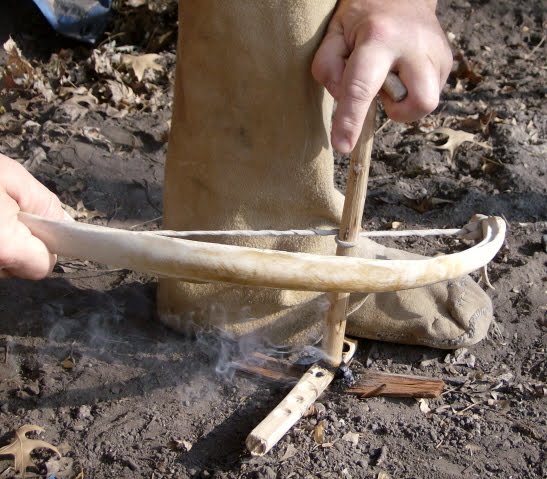Saturday, May 5, 2012
Using Mullein Stems for Bowdrill Firemaking
I love making friction fires...rubbing two sticks together. There is something fascinating about spinning a shaft of wood against another to give life to a glowing ember. Some days I have to spin up a hot coal just to smell the smoldering wood...that's my aroma-therapy.
Earlier this year I started using more mullein stalks as drills for bowdrill firemaking. Mulleins are common in the roadsides and waste areas around eastern Nebraska. They are easily recognized by their velvety rosette of leaves, woody stem, and flowerhead stalk. The woody stalk makes a good drill component when used with a cottonwood fireboard. The stem consists of a sturdy woody outer shell with a styrofoam-like inner pith. The soft inner pith and hard outer stem can be a problem sometimes. A couple of technics help...
One thing I found is that the drill has a tendency to bore through the fire board, thinning or shaving the outer
stem near the business end helps.
Also, cannot sharpen the top of the drill to a point, to spin freely in the socket, because of the soft pithy
core. To aid this, I tied a piece of
cordage around the top of the drill so it would not easily split. Then, sharpening a
short hard wood stem to a point, I force it into the styrofoam like pith. Now I have a hard wooden top to my drill that can take more abuse and be sharpened to spin more freely in the handheld socket.
Wednesday, May 2, 2012
Natakaaru (Pawnee) - Cottonwood Tree
It's been over a year since I've posted...sorry. Life happens. I figure it's time.
I went out to the lakes to clear my thoughts. Some of the female cottonwood trees were already dropping downy seed heads. This normally occurs May to June. To a primitive skills practitioner, I gather the down to add to tinder nests for friction fire making. Alone, the down does not work well, combined it helps to spread the hot coal to the coarser materials. Of course, the dead dry branches work well for the fireboard and drill components of a bowdrill set.
Cottonwood trees are abundant in Nebraska, easily recognized, and useful to the early Native Americans cultures. The papery inner bark works great for tinder nests, twined into cordage, as well as survival food. The Hopi Indians, of Arizona, considered the cottonwood sacred. They used the root to carve Kachina dolls. In spring, before leaves appear, the waxy buds were boiled to make a yellowish dye pigment.
Medicinally, and I wasn't aware of this, a wash of boiled leaf buds or bark was used for burns, cuts, bruises, and skin irritations. The tannin has astringent properties tightening tissue and stopping bleeding.
Pictured top is down bursting from seed pods.
At left are female seed buds.
I went out to the lakes to clear my thoughts. Some of the female cottonwood trees were already dropping downy seed heads. This normally occurs May to June. To a primitive skills practitioner, I gather the down to add to tinder nests for friction fire making. Alone, the down does not work well, combined it helps to spread the hot coal to the coarser materials. Of course, the dead dry branches work well for the fireboard and drill components of a bowdrill set.
Cottonwood trees are abundant in Nebraska, easily recognized, and useful to the early Native Americans cultures. The papery inner bark works great for tinder nests, twined into cordage, as well as survival food. The Hopi Indians, of Arizona, considered the cottonwood sacred. They used the root to carve Kachina dolls. In spring, before leaves appear, the waxy buds were boiled to make a yellowish dye pigment.
Medicinally, and I wasn't aware of this, a wash of boiled leaf buds or bark was used for burns, cuts, bruises, and skin irritations. The tannin has astringent properties tightening tissue and stopping bleeding.
Pictured top is down bursting from seed pods.
At left are female seed buds.
Subscribe to:
Posts (Atom)




